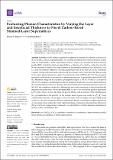Evaluating Phonon Characteristics by Varying the Layer and Interfacial Thickness in Novel Carbon-Based Strained-Layer Superlattices
Author(s)
Talwar, Devki N.; Becla, Piotr
Downloadsolids-04-00018.pdf (1.849Mb)
Publisher with Creative Commons License
Publisher with Creative Commons License
Creative Commons Attribution
Terms of use
Metadata
Show full item recordAbstract
Systematic results of lattice dynamical calculations are reported as a function of m and n for the novel (SiC)<sub>m</sub>/(GeC)<sub>n</sub> superlattices (SLs) by exploiting a modified linear-chain model and a realistic rigid-ion model (RIM). A bond polarizability method is employed to simulate the Raman intensity profiles (RIPs) for both the ideal and graded (SiC)<sub>10-Δ</sub>/(Si<sub>0.5</sub>Ge<sub>0.5</sub>C)<sub>Δ</sub>/(GeC)<sub>10-Δ</sub>/(Si<sub>0.5</sub>Ge<sub>0.5</sub>C)<sub>Δ</sub> SLs. We have adopted a virtual-crystal approximation for describing the interfacial layer thickness, Δ (≡0, 1, 2, and 3 monolayers (MLs)) by selecting equal proportions of SiC and GeC layers. Systematic variation of Δ has initiated considerable upward (downward) shifts of GeC-(SiC)-like Raman peaks in the optical phonon frequency regions. Our simulated results of RIPs in SiC/GeC SLs are agreed reasonably well with the recent analyses of Raman scattering data on graded short-period GaN/AlN SLs. Maximum changes in the calculated optical phonons (up to ±~47 cm<sup>−1</sup>) with Δ = 3, are proven effective for causing accidental degeneracies and instigating localization of atomic displacements at the transition regions of the SLs. Strong Δ-dependent enhancement of Raman intensity features in SiC/GeC are considered valuable for validating the interfacial constituents in other technologically important heterostructures. By incorporating RIM, we have also studied the phonon dispersions [<inline-formula><math xmlns="http://www.w3.org/1998/Math/MathML" display="inline"><semantics><mrow><msub><mrow><msubsup><mrow><msub><mrow><mi mathvariant="sans-serif">ω</mi></mrow><mrow></mrow></msub></mrow><mrow><mi mathvariant="normal">j</mi></mrow><mrow><mi mathvariant="normal">S</mi><mi mathvariant="normal">L</mi></mrow></msubsup></mrow><mrow></mrow></msub><mfenced separators="|"><mrow><mover accent="true"><mrow><mi mathvariant="bold">q</mi></mrow><mo>→</mo></mover></mrow></mfenced></mrow></semantics></math></inline-formula>] of (SiC)<sub>m</sub>/(GeC)<sub>n</sub> SLs along the growth [001] as well as in-plane [100], [110] directions [i.e., perpendicular to the growth]. In the acoustic mode regions, our results of <inline-formula><math xmlns="http://www.w3.org/1998/Math/MathML" display="inline"><semantics><mrow><msub><mrow><msubsup><mrow><msub><mrow><mi mathvariant="sans-serif">ω</mi></mrow><mrow></mrow></msub></mrow><mrow><mi mathvariant="normal">j</mi></mrow><mrow><mi mathvariant="normal">S</mi><mi mathvariant="normal">L</mi></mrow></msubsup></mrow><mrow></mrow></msub><mfenced separators="|"><mrow><mover accent="true"><mrow><mi mathvariant="bold">q</mi></mrow><mo>→</mo></mover></mrow></mfenced><mo> </mo></mrow></semantics></math></inline-formula> have confirmed the formation of mini-gaps at the zone center and zone edges while providing strong evidences of the anti-crossing and phonon confinements. Besides examining the angular dependence of zone-center optical modes, the results of phonon folding, confinement, and anisotropic behavior in (SiC)<sub>m</sub>/(GeC)<sub>n</sub> are compared and contrasted very well with the recent first-principles calculations of (GaN)<sub>m</sub>/(AlN)<sub>n</sub> strained layer SLs.
Date issued
2023-10-01Department
Massachusetts Institute of Technology. Department of Materials Science and EngineeringPublisher
Multidisciplinary Digital Publishing Institute
Citation
Solids 4 (4): 287-303 (2023)
Version: Final published version